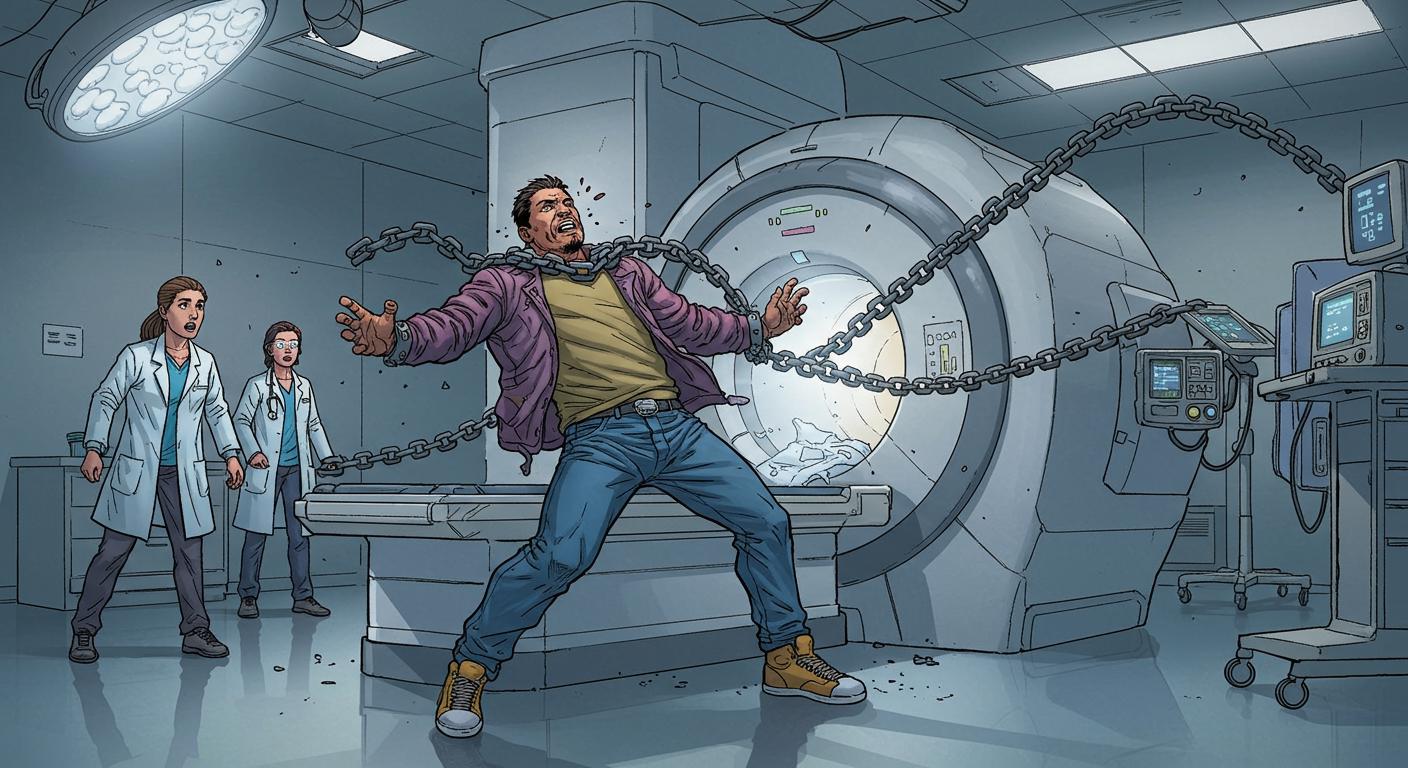There are poor decisions, and then there are the kind that get literalized in the most painful way possible. As documented in NewsNation, a 61-year-old man in Westbury, New York, wound up facing the full, relentless force of magnetic resonance technology after entering an MRI room—while sporting what police described as a “large metallic chain” around his neck. The results were precisely as physics would predict, which is to say: not good.
Chain Reactions, the Hard Way
According to authorities cited by PIX11, the incident occurred at Nassau Open MRI on Old Country Road around 4:30 p.m. on Wednesday. Police indicated the man entered the MRI suite without permission at a time when, crucially, the machine was already in use. In a detail highlighted by both outlets, the “large metallic chain” triggered the catastrophe, with the magnetic field pulling the wearer directly into the device.
Adding to the surreal timeline, officials told NewsNation the man immediately suffered a medical episode and was transported to a local hospital, reportedly in critical condition. No additional details about his condition or the circumstances surrounding how he was able to access the restricted area were provided by police at the time of reporting.
The Unyielding Laws of Magnetism
The risks involved in combining strong magnets with unvetted accessories aren’t exactly an industry secret. As information from the National Institute of Biomedical Imaging and Bioengineering included in NewsNation’s coverage puts it, an MRI’s magnetic field “extends beyond the machine and exerts very powerful forces on objects of iron, some steels, and other magnetizable objects; it is strong enough to fling a wheelchair across the room.” Not so much a metaphor as a rather blunt reminder that for certain objects (and, biologically, anyone attached to them), there’s no such thing as resisting a 1.5-tesla tractor beam.
Described in both NewsNation and PIX11, MRI facilities treat these risks with all the gravity they deserve. Before anyone even thinks about stepping inside, they’re quizzed on every possible bit of metal—jewelry, zippers, credit card strips, even surgeries past. It’s rarely ambiguous: the protocols are there, the signs are posted, the staff presumably vigilant. Yet in this case, as the outlets make clear, those protocols either slipped, were ignored, or were circumvented in a moment of unknowable impulse.
More Warnings Than a Haunted House
The fact that someone managed to get inside an active MRI while wearing a conspicuous metal chain raises uncomfortable questions: Was there a failure in protocol, a distraction among the staff, or perhaps simple human error? Police have not disclosed exactly how the man gained access to the restricted area, nor whether the chain was visible to others before the incident unfolded.
As the PIX11 article notes, the man was in critical condition following what authorities described as a medical emergency. No mention yet of any injuries to staff or damage to the machine, which, in the world of MRI mishaps, almost qualifies as a narrow miss.
One wonders what goes through someone’s head at the threshold of an MRI suite—a place notorious for lists of forbidden objects and dire warnings about metal. Have safety signs become white noise, drowned out by routine? Or do people quietly convince themselves that “it won’t happen to me,” even when dealing with one of the strongest magnets outside a physics lab?
A Gravitational Case Study in Hard Lessons
For all the impressive engineering behind MRI technology, there’s something both ironic and inevitable about its recurring role as stage for these almost mythic cautionary tales. Was this misfortune rooted in negligence, confusion, or a stubborn attachment to personal style—one literally yanked away in the most memorable fashion imaginable? The outlets leave that open, as the police withheld interpretation.
Still, the rule stands tall: In a contest between soft tissue and superconducting magnets, the magnet never loses composure. If nothing else, this story serves as a vivid, if unfortunate, refresher for us all: Nature may abhor a vacuum, but it downright craves a magnetic misadventure. Would anyone bet against the possibility of someone trying their luck again, despite physics, signage, and precedent? Stranger things have happened.







